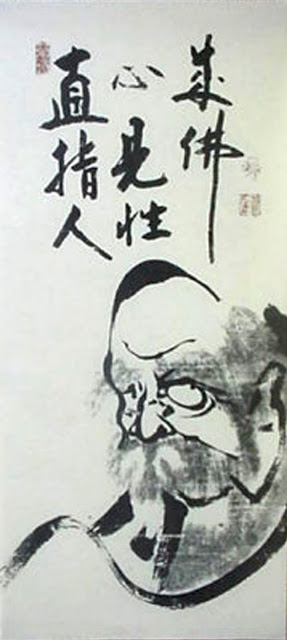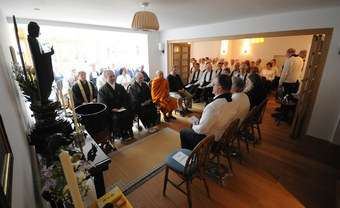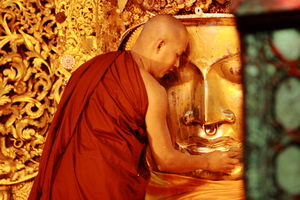Introduction to the Zen School
written by Venerable Myokyo-ni
The Zen School of Buddhism likes to call itself the Buddha-Heart School because it aims to present the essence of the Buddha’s teaching of the way to Full Awakening or Enlightenment.

Bodhidharma, the first Zen patriarch
Historical Roots
Buddhism arose in India around 500 BCE. It spread fairly rapidly into Southeast Asia, northward through Central Asia into China around 100 CE and then the Far East, finally reaching Tibet by 700–800 CE. Both its age and its spread make Buddhism a well-travelled religion. In the course of its travels it has shown that its roots can grow in any soil, provided its spirit is replanted and not just its forms. The forms change, and have changed, with prevailing geographical and cultural conditions. But however varied they may have become, the central theme is of Buddhism is constant: our human problems and sufferings and a way to transcend them. This culminates in a new way of seeing and beholding, which is all-embracing, peaceful and compassionate, free from fear and thus joyful.
No detailed record remains of the life of the historical person who is referred to as the Buddha, the Awakened or Enlightened One. However, all the different Buddhist traditions are remarkably unanimous about the main tenets of his life, which we may therefore take as symbolic of the Way an individual has to travel in order to come to the same insight. Differences in emphasis and formulations of this Way, and variations of it, make up its various schools. Books on them are now easily accessible, and here we need only note that the Zen School belongs to the Northern branch of Buddhism (Mahayana), as distinct from the Southern branch, which is prevalent in Southeast Asia.
A Training Open to Ordained and Laity

From its beginning, training in Zen has always been open to monks and lay people, men and women, and the texts tell of some great laymen and laywomen. But the places where this training could be undergone, and where it was shown by the lives and style of the resident community under a teacher, have always been monastic institutions. This is not necessarily because they are better but because they encourage cultivation and continuity; and they also offer single-mindedness of purpose to those who, feeling the calling, dedicate their lives to handing on the Buddha’s message and, more importantly, the Way that leads to its realisation. No asset or inheritance is of any real value unless it is realised and thus made available for use. That reminds us of the Buddha’s own realisation on Awakening: ‘How wonderful, how mysterious, all beings are fully endowed with the Tathagata’s Wisdom and Power. But sadly, human beings, because of their attachments, are not aware of it.’
The Spirit and Form of the Training
And so, what concerns us is the Way through which this wisdom and power is to be realised. We are not in Japan, and to indulge in exotic forms and to imitate cultural accretions will only lead us astray. But we must have a good look at what the message of the Buddha actually tells us, why Zen training is as it is and why it is effective for one who feels impelled to undergo it and to stick it out.
 The late Master Sesso of Daitoku-ji monastery held up his hand, fingers outstretched, and smilingly said, ‘A flower may have many petals; none are identical but all are nourished by the same sap that rises along the stalk. It is the same with religions.’ And he ticked them off on his fingers: ‘Hinduism, Christianity, Judaism, Buddhism, Islam. All differ in their formulations, doctrines, rites, yet all express in their different forms that same essence that informs them all. And,’ he added, suddenly very serious, ‘in all of them there is a danger, greatest perhaps in Buddhism because it has so many forms, that the essence can be mistaken for the form it is manifested in. Each form, as with the flower petal, if followed down leads back to the essence. Jumping from one form to another, or comparing them, only creates confusion.’
The late Master Sesso of Daitoku-ji monastery held up his hand, fingers outstretched, and smilingly said, ‘A flower may have many petals; none are identical but all are nourished by the same sap that rises along the stalk. It is the same with religions.’ And he ticked them off on his fingers: ‘Hinduism, Christianity, Judaism, Buddhism, Islam. All differ in their formulations, doctrines, rites, yet all express in their different forms that same essence that informs them all. And,’ he added, suddenly very serious, ‘in all of them there is a danger, greatest perhaps in Buddhism because it has so many forms, that the essence can be mistaken for the form it is manifested in. Each form, as with the flower petal, if followed down leads back to the essence. Jumping from one form to another, or comparing them, only creates confusion.’
There is no need to elaborate on this – we know what happens when we start comparing, vying and warring with each other about whose way is the best. In the Buddha-Heart School, therefore, we are concerned with the essence but are aware that it can only be realised in a form.
Eastern and Western Perspectives

The Zen Way starts in the landscape of Buddhism; and since this is very different in its outlook and basic assumptions from our Graeco-Christian landscape, our first need is to become clear about our own assumptions. Why? Our own basic assumptions are so obvious to us that we never question them; they are embedded in our thought patterns and expressed in our languages. I ‘have’ hands and feet, they are ‘mine’. I think, ‘Cogito ergo sum.’ From the creator-god the power of whose word brought the world and all that exists into being to such mundane occurrences as ‘ I stand up’, ‘I think’, ‘I feel’ etc. we are convinced that for any action there must be a doer who instigates it.
This is the Western mode of understanding. In our time, at the end of the twentieth century, this doer ‘I’ with all its concerns has become all but boundless, as we have lost faith in or forgotten our creator-god without whose consent we are as naught. So among many other ills, we now suffer from the danger of becoming inflated beyond the limits of our capacity. We need only to look at our newspapers to see how strident our self-importance has become. No use blaming the media – it only reflects ourselves.
Now let us look at the Eastern landscape and its basic assumptions. Buddhism has grown in this soil, and thus acquaintance with this landscape is essential for the trainee. The Eastern perspective sees no creator-god who intentionally brings the world into being. Things and actions take place of themselves without the need for a planner or doer. This produces a totally different way of thinking and language pattern. In Japanese until quite recently, before Western influence took hold, pronouns were of little importance and rarely used. ‘I have two hands’ or ‘I am angry’ would have been rendered just as ‘there are two hands’ or ‘there is anger’.
Moreover, and most importantly, in the East thinking is a function of the heart rather than the head. Even more disconcertingly, although there are specific Buddhist terms for ‘consciousness’ and ‘thoughts’, they are used synonymously. The Easterner thinks in/with the heart. The key Buddhist term citta (Sanskrit), hsin (Chinese) or shin (Japanese) cannot therefore be adequately translated into any Western language. This key term was and often still is translated as ‘mind’. But that masks or conceals the connotations of feeling, emotion, passion, which we naturally associate with the heart rather than with the mind, the function and instrument of thinking associated with the head.
Another misleading term is ‘purity’, which, although in a way correct, for us also carries moral overtones such as innocence and freedom from sin, without accretion or admixtures, like pure water. To the Buddhist, this state of purity, clean without addition, connotes the state of nothingness (sunyata), that is, empty, containing nothing. A pure heart is a heart empty of all assumptions.
Another term that we easily misconstrue is ‘eternity’. Eternity in Buddhism is not everlasting but a full, total moment in which time may stand still or may not. This gives the clue: eternity is not in time and has nothing to do with time. All that can be said about it is that it is, and even that is too much.
Deliverance From the Burden of ‘I’

Many of the basic Buddhist assumptions point to the inexpressible, which, in Zen parlance, ‘is not a thing, is not a place’ but rather is an experience. This experience delivers the individual, previously separate and alone, from the straightjacket of ‘I’. Further cultivated it becomes a new attitude or state of awareness with new perception and relatedness. Variously termed Satori, Enlightenment, Awakening, this state lies beneath the sense of ‘I’ and thus emerges of itself when ‘I’ is forgotten or no longer there. As a momentary experience, it arises of itself at times when we are deeply moved, perhaps when looking at a sunset and being ‘carried out of ourselves’. Although the memory of such a moment is apt to stay with us, the moment happens of itself and cannot be deliberately invoked. The expectation is apt to drive it away; setting up the same conditions will not bring it about again; and contrary to some New Age thinking, mere wantonness or impetuosity is equally ineffective. In short, it is an experience of the absence of ‘I’, and therefore no volitional means can bring it about – ‘all deliberation misses the target’.
Although we all have had such moments or intimations, we cannot bring about such an experience or perception by an act of will or by an arrangement of circumstances. And as a state or new attitude in which life is lived, it does not come about without devoted effort and practice because it involves a radical change of heart.
